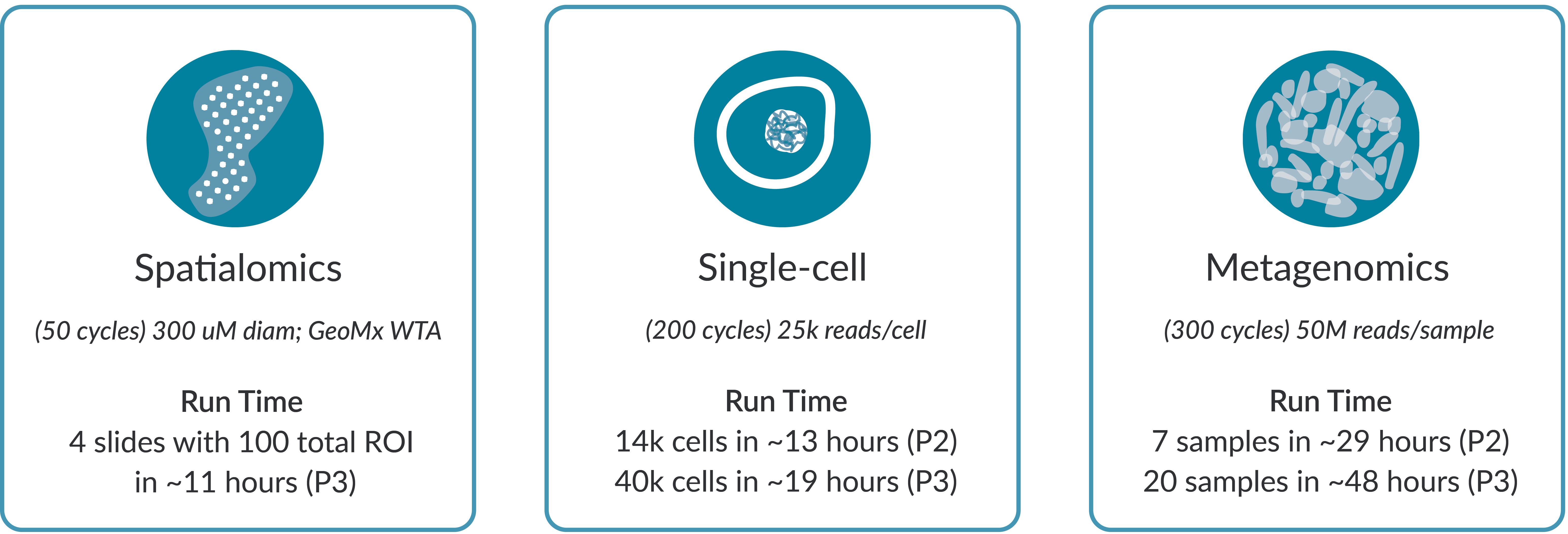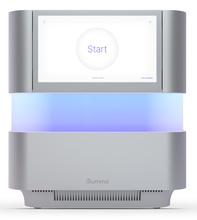The NextSeq 2000 uses advancements in optics, instrument design, and 2-channel chemistry to increase output. This new sequencing technology makes it possible for researchers to sequence a range of conventional and emerging applications by increasing throughput while cutting down on costs per run when compared to its predecessor, the NextSeq 550.
The result is a highly flexible and scalable benchtop system that offers the highest cluster density flow cell of any on-market NGS system to date. It drives down the cost per gigabase making it more accessible for researchers.
As a high-throughout instrument, the NextSeq 2000 is a scalable platform that supports more complex, informative studies and a broad range of standard NGS methods, as well as emerging techniques, including spatialomics.

This instrument expands the UMGC’s comprehensive sequencing portfolio by replacing the NextSeq 550 as the instrument of choice for projects needing a fast turnaround and increased flexibility.
Output
There are three types of flow cell options, the P1, P2, and P3, available with a range of outputs to accommodate a wide variety of NGS projects. The P3 is a high-output flow cell that generates up to 1 billion reads per run, more than nearly three times the previously available NextSeq 550.
At 90 million reads per run, the P1 flow cell is an attractive option for viral and pathogen sequencing, “smaller” batch RNA-Seq, targeted panels, and more.

Benefits
The primary advantages of the NextSeq 2000 are the sequencing speed and multiple run configurations that enable sequencing outputs of 27 - 300 Gb per run.
Four run configurations are available: the 100-cycle kit, the 200-cycle kit, the 300-cycle kit, and the 50-cycle kit, which is available in the P3 only. The added 50-cycle kit targets infectious disease, small RNA, and spatial transcriptomics applications.
In addition, users have the benefit of not needing to wait to fill a large, multi-lane flow cell (NovaSeq) before data can be generated. Whether it is the P1, P2, or P3 flow cell, researchers purchase the full NextSeq flow cell (no lane splitting) and sequencing will begin once libraries are complete and the instrument is available.
Drawbacks
Due to the 2-channel chemistry, the NextSeq does not tolerate low diversity libraries as well as the MiSeq 4-channel platform, and in order to generate high-quality data, a higher spike-in concentration of a diverse control library is required. Thus, amplicon libraries with low sequence diversity should be designed with phasing bases to frameshift low-diversity regions.
In addition, output capacity for custom libraries, including amplicon libraries and low-diversity applications, may generate up to 25% less data in an effort to improve data quality.
Questions?
Please contact Elyse Cooper or Aaron Becker at next-gen@umn.edu for further details on the NextSeq platform.
UMN Rates
High Output Sequencing Rates Summary
| 50-cycle (25 PE or 50 SR) | Savings Tier | Speed Tier | Priority Tier |
|---|---|---|---|
| NextSeq P3. 1 B reads/lane. | $2,242.24 | $3,315.05 | $3,644.49 |
| Turnaround time. | 6 - 11 days | 4 - 6 days | 2 - 3 days |
| 100-cycle (50 PE or 100 SR) | Savings Tier | Speed Tier | Priority Tier |
|---|---|---|---|
| NextSeq P2. 360 M reads/lane. | $1,755.09 | $2,602.93 | $2,911.99 |
| Turnaround time. | 6 - 11 days | 4 - 6 days | 2 - 3 days |
| NextSeq P3. 1 B reads/lane. | $3,038.45 | $4,478.93 | $4,841.68 |
| Turnaround time. | 6 - 11 days | 4 - 6 days | 2 - 3 days |
| 200-cycle (100 PE) | Savings Tier | Speed Tier | Priority Tier |
|---|---|---|---|
| NextSeq P2. 360 M reads/lane. | $2,903.22 | $4,281.26 | $4,638.35 |
| Turnaround time. | 6 - 11 days | 4 - 6 days | 2 - 3 days |
| NextSeq P3. 1 B reads/lane. | $4,033.49 | $5,933.47 | $6,337.85 |
| Turnaround time. | 6 - 11 days | 4 - 6 days | 2 - 3 days |
| 300-cycle (150 PE) | Savings Tier | Speed Tier | Priority Tier |
|---|---|---|---|
| NextSeq P1. 90 M reads/lane. | $1,571.35 | $2,334.35 | $2,635.72 |
| Turnaround time. | 6 - 11 days | 4 - 6 days | 2 - 3 days |
| NextSeq P2. 360 M reads/lane. | $3,702.70 | $5,449.93 | $5,840.47 |
| Turnaround time. | 7 - 12 days | 5 - 7 days | 3 - 4 days |
| NextSeq P3. 1 B reads/lane. | $5,228.18 | $7,679.83 | $8,134.20 |
| Turnaround time. | 7 - 12 days | 5 - 7 days | 3 - 4 days |
| 600-cycle (300 PE) | Savings Tier | Speed Tier | Priority Tier |
|---|---|---|---|
| NextSeq P1. 90 M reads/lane. | $2,153.93 | $3,185.96 | $3,511.70 |
| Turnaround time. | 7 - 12 days | 5 - 7 days | 3 - 4 days |
| NextSeq P2. 300 M reads/lane. | $3,991.31 | $5,871.80 | $6,274.42 |
| Turnaround time. | 7 - 12 days | 5 - 7 days | 3 - 4 days |
Notes
1. Output: In an effort to improve data quality, the output capacity for custom libraries, including amplicon libraries and low-diversity applications, may generate up to 25% less data due to the addition of PhiX.
2. Tiers: Turnaround time (TAT) is in business days. TAT is for sequencing only and does not factor in the TAT for library prep or other companion services. Availability for the Priority Tier is limited; contact next-gen@umn.edu to see if this is a current option. More information about Pricing Tiers.
External Rates
High Output Sequencing Rates Summary
| 50-cycle (25 PE or 50 SR) | Savings Tier | Speed Tier | Priority Tier |
|---|---|---|---|
| NextSeq P3. 1 B reads/lane. | $3,109.88 | $4,052.77 | $4,421.16 |
| Turnaround time. | 6 - 11 days | 4 - 6 days | 2 - 3 days |
| 100-cycle (50 PE or 100 SR) | Savings Tier | Speed Tier | Priority Tier |
|---|---|---|---|
| NextSeq P2. 360 M reads/lane. | $2,434.23 | $3,181.26 | $3,526.48 |
| Turnaround time. | 6 - 11 days | 4 - 6 days | 2 - 3 days |
| NextSeq P3. 1 B reads/lane. | $4,214.16 | $5,477.15 | $5,883.41 |
| Turnaround time. | 6 - 11 days | 4 - 6 days | 2 - 3 days |
| 200-cycle (100 PE) | Savings Tier | Speed Tier | Priority Tier |
|---|---|---|---|
| NextSeq P2. 360 M reads/lane. | $4,026.6 | $5,235.23 | $5,635.05 |
| Turnaround time. | 6 - 11 days | 4 - 6 days | 2 - 3 days |
| NextSeq P3. 1 B reads/lane. | $5,594.23 | $7,257.26 | $7,710.85 |
| Turnaround time. | 6 - 11 days | 4 - 6 days | 2 - 3 days |
| 300-cycle (150 PE) | Savings Tier | Speed Tier | Priority Tier |
|---|---|---|---|
| NextSeq P1. 90 M reads/lane. | $2,179.38 | $2,852.55 | $3,189.03 |
| Turnaround time. | 6 - 11 days | 4 - 6 days | 2 - 3 days |
| NextSeq P2. 360 M reads/lane. | $5,135.45 | $6,665.49 | $7,103.34 |
| Turnaround time. | 7 - 12 days | 5 - 7 days | 3 - 4 days |
| NextSeq P3. 1 B reads/lane. | $7,251.19 | $9,394.50 | $9,904.91 |
| Turnaround time. | 7 - 12 days | 5 - 7 days | 3 - 4 days |
| 600-cycle (300 PE) | Savings Tier | Speed Tier | Priority Tier |
|---|---|---|---|
| NextSeq P1. 90 M reads/lane. | $2,987.39 | $3,894.78 | $4258.96 |
| Turnaround time. | 7 - 12 days | 5 - 7 days | 3 - 4 days |
| NextSeq P2. 300 M reads/lane. | $5,535.71 | $7,181.78 | $7,633.36 |
| Turnaround time. | 7 - 12 days | 5 - 7 days | 3 - 4 days |
Notes
1. Output: In an effort to improve data quality, the output capacity for custom libraries, including amplicon libraries and low-diversity applications, may generate up to 25% less data due to the addition of PhiX.
2. Tiers: Turnaround time (TAT) is in business days. TAT is for sequencing only and does not factor in the TAT for library prep or other companion services. Availability for the Priority Tier is limited; contact next-gen@umn.edu to see if this is a current option. More information about Pricing Tiers.
Submission
How to order
Researchers can download the appropriate submission form for submitting samples or submitting client-made libraries. Once the form has been completed, please submit the submission by emailing next-gen@umn.edu.
Forms
Illumina Sequencing Request Form (Libraries)
Illumina Sequencing Request Form (Samples)
Samples can be dropped off at one of our campus locations
1-210 Cancer & Cardiovascular Research Building (Minneapolis campus)
20 Snyder Hall (St. Paul campus)
Samples can be shipped to the following address:
Please send the tracking information to next-gen@umn.edu.
UMN Genomics Center
ATTN: Nasia Mead
3510 Hopkins Place N.
Building 4 Suite W402
Oakdale, MN 55128
612-625-7736
Deliverables
Data Release
There are four options for transferring data from the UMGC to clients: 1) delivery to the Minnesota Supercomputing Institute’s (MSI) high-performance file system, 2) download from a secure website, 3) download with Globus, or 4) shipment on an external hard drive. Please indicate your data delivery preference when placing an order for sequencing.
1. MSI storage
Internal clients have their data released to MSI's Shared User Resource Facility Storage (SURFS). Delivered data will be located in the "data_delivery" folder in your group's folder on MSI's primary filesystem (home/GROUP/data_delivery/umgc). MSI does not charge for SURFS storage costs, but files expire and are removed one year after they've been delivered. Files should be copied to other MSI storage locations such as Tier2, Tier3, or your group's "shared" folder before they expire.
2. Web download
Internal clients that opt-out of MSI storage and external clients can download their data from a secure website using either a web browser or a command-line download tool, complete instructions are provided in an email from the UMGC. The client’s data is available for download for 30 days, after which the data will be removed from the data download website and the client takes responsibility for storing the data.
3. Globus
Internal and External clients can use Globus to download their data. This is the recommended method for external clients to download large datasets.
4. Hard drive
External clients may have data shipped on a hard drive purchased by the UMGC and invoiced to the client at a cost of $250 per hard drive.
Data Recovery
The UMGC archives most customer data for a year and some datasets are retained for 5 years or more. If you need a dataset re-delivered email a request to next-gen@umn.edu to initiate data recovery. The UMGC does not provide any guarantee that data can be successfully recovered from the archive.
FAQs
Do you accept client-made libraries?
Yes, please consult with UMGC staff before submitting client-made libraries by emailing next-gen@umn.edu.
We recommend that pooling be done at UMGC as PicoGreen concentrations are used for balancing libraries. However, clients may choose to pool themselves.
Client-made libraries will have the following services performed on them before proceeding with sequencing.
- PicoGreen (concentration of library)
- DNA Agilent High Sensitivity chip (size of library)
- KAPA QC (functionality of library)
Where should samples be shipped?
University of Minnesota Genomics Center
1475 Gortner Ave.
28 Snyder Hall
St. Paul, MN 55108
612-625-7736

